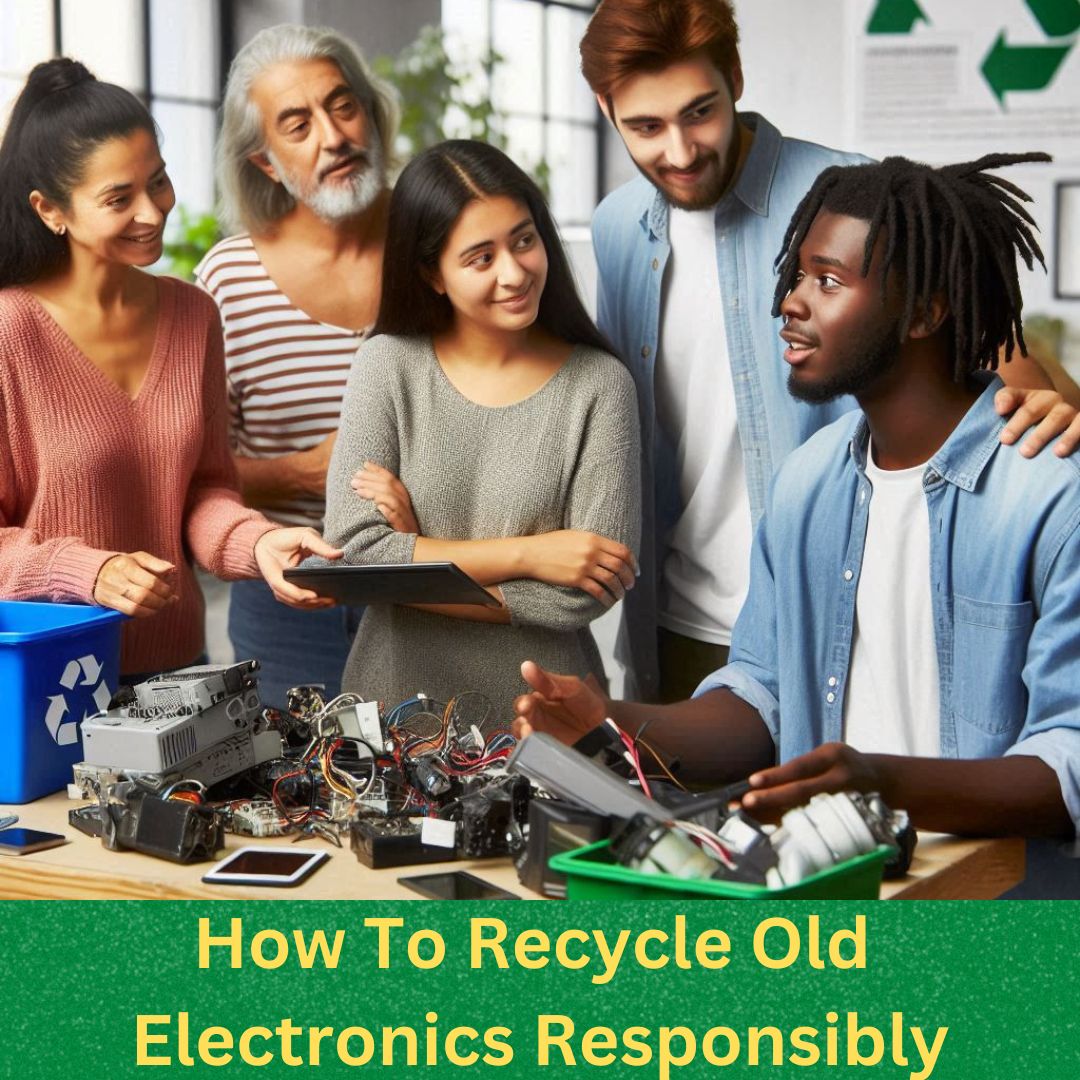 Recycling old electronics responsibly is essential for preserving our environment and keeping hazardous waste out of landfills.
Recycling old electronics responsibly is essential for preserving our environment and keeping hazardous waste out of landfills.
Old devices such as computers, smartphones, and televisions all contain components that can be reused, refurbished, or safely disposed of.
In this article, I explain how to recycle old electronics responsibly and offer advice on identifying recyclers, protecting personal data, and looking into other options for repurposing devices.
Step 1: Assess Your Electronic Waste
Before taking any action, it is useful to assess the electronic waste you have accumulated.
I start by gathering all devices or gadgets that I no longer use. This can include outdated cell phones, laptops that sit idle, old printers, and even accessories like chargers.
Not every electronic device is treated the same when it comes to recycling. Many items may need special handling because they contain toxic materials.
Taking the time to check out each device allows you to determine if the item still works, has refurbishing potential, or contains components that require special processing.
Considerations When Assessing Your Devices:
- Determine if the device still functions or if it is broken.
- Check if the item has potential value if refurbished or repaired.
- Identify devices that contain hazardous substances such as batteries or mercury.
- List items you may decide to donate or repurpose instead of recycling immediately.
This careful approach ensures that you are recycling responsibly and not wasting resources that could still be put to work.
By taking a close look at each device, you can figure out the best way to treat every piece of electronic equipment.
Step 2: Research Recycling Options
Once you have a clear picture of your electronic waste, it is important to research available recycling options.
I get on the lookout for local recycling facilities and certified e-waste recyclers.
Many communities have drop-off centers that specialize in handling old electronics, and some manufacturers even offer mail-in programs tailored for their products.
Spending a little extra time to map out your options can make the process smoother and more effective.
Ways to Find a Reliable Recycler:
- Visit government or municipal websites that list certified recycling facilities.
- Contact local waste management offices to request guidelines and drop-off information.
- Check for manufacturer mail-in recycling programs.
- Search online for reviews and ratings of e-waste recycling centers in your area.
This step is very important because working with certified recyclers ensures that your electronics are processed safely, in compliance with environmental standards and local laws.
Taking extra time to research helps you avoid any pitfalls and makes sure that everything is handled in an all-in-one, responsible manner.
Step 3: Protect Your Data Before Recycling
When planning to recycle an old electronic device, I make it a routine practice to secure any personal data contained within it.
Many devices store sensitive files such as documents, photos, or financial records.
Removing personal information not only protects your privacy but also increases the chance that the device can be refurbished and used by someone else.
It is really important to back up your files and clear out any data before handing over the device.
Practical Tips for Data Protection:
- Backup any important data and then perform a factory reset on the device.
- Remove memory cards or hard drives from computers if possible.
- Physically destroy data storage components if the device is no longer of value.
- Consult the manufacturer’s guidelines for secure data deletion.
Securing your data helps prevent identity theft and ensures that personal information does not fall into the wrong hands.
This practice also gives recyclers a chance to repurpose the technology more efficiently.
With personal data safely removed, the cycle of reuse can truly take off.
Step 4: Understand Environmental Impacts
Recycling electronics responsibly is not just about disposing of unwanted items. It also involves understanding the environmental impacts of e-waste.
I make an effort to learn about the dangers associated with improper disposal. Traditional landfills can release toxic chemicals from electronic components into the soil and water.
When these toxic substances are allowed to seep into the environment, both wildlife and human health are put at risk.
Key Environmental Considerations:
- Electronic devices contain metals such as lead, cadmium, and mercury which are harmful to both wildlife and human health.
- Recycling helps recover valuable materials that can be used in new devices, reducing the need for mining.
- Effective recycling reduces greenhouse gas emissions associated with manufacturing new electronics.
- Safe handling of hazardous waste ensures that communities are not exposed to dangerous chemicals.
Understanding these impacts reinforces the need to handle electronic waste with care.
It is a reminder that every device recycled is a small victory in our effort to ease the strain on the earth.
Staying informed about these issues lets you make smart choices every time you decide on a recycling option.
Step 5: Explore Donation and Repurposing Options
Not every old electronic device needs to be recycled immediately. I sometimes find that devices with minor issues or those that still work well can be donated or repurposed rather than recycled.
This approach extends the useful life of a product and helps to reduce overall waste. Instead of just tossing away devices, consider giving them a new purpose.
When a device is still functional, it can continue to benefit someone else and contribute to a more circular economy.
Donation and Repurposing Strategies:
- Donate devices to schools, libraries, or community centers if they are still functional.
- Sell or give away electronics through reputable platforms to those who might repair them.
- Participate in local programs that refurbish and donate electronics to underprivileged groups.
- Explore community events or initiatives that focus on digital inclusion where old devices can be useful.
This method not only benefits the community but also minimizes the amount of e-waste that needs to be processed.
When an electronic device is given a second chance, it delays the moment it becomes waste.
In doing so, it plays a role in reducing the demand for new products and helps conserve resources.
Step 6: Implement a Recycling Plan
After collecting, assessing, and researching your options, it is time to put a recycling plan into action.
I schedule regular intervals to remove old electronics and then contact local recyclers or donation centers.
Having a plan makes the process orderly and ensures that you do not accumulate hazardous waste over time.
A well-thought-out schedule helps ensure that each device is either repurposed or recycled in a timely manner.
Building an Effective Recycling Plan:
- Create a timeline for when you will gather electronics and transport them to a recycling center.
- Keep a list of certified recyclers and donation centers, including contact information.
- Decide in advance which items will be recycled, repurposed, or donated.
- Review and update your plan annually to adjust for new devices or changes in recycling guidelines.
Making a plan helps maintain consistency in how you handle electronic waste.
A structured approach also serves as a reminder to keep an eye out for the latest recycling practices and innovation in waste management.
By scheduling regular reviews and updates, you can keep your plan current and effective over the long term.
Step 7: Common Questions and Troubleshooting
Sometimes questions arise about recycling electronics properly.
I have encountered common issues and practical answers by thoroughly researching the subject and relying on community advice.
This section is meant to provide clarity and act as a guide for those who might be facing difficulties with the recycling process.
What if I Cannot Find a Nearby Recycling Facility?
If your local area does not have a specifically designated e-waste facility, consider contacting local government waste management offices for recommendations.
Some communities offer temporary drop-off events and mobile recycling units.
These alternative solutions may be available during certain periods, helping you manage your waste in the meantime.
Which Electronics Can Be Recycled?
The majority of electronic devices, including computers, smartphones, televisions, and small appliances, can be recycled.
However, items like batteries or parts with hazardous substances may need special handling.
Always consult with the recycling center to understand what they accept so that you can be sure you are following the proper protocols.
How Do I Handle Hazardous Components?
- Check if the device contains lithium batteries, mercury, or other toxic substances.
- Ask the recycler about special procedures for hazardous components.
- If you are unsure, look up local guidelines on handling e-waste hazardous materials.
These common questions underscore the importance of staying sharp and informed when handling electronic waste.
By taking the time to ask and check in with local resources, you can make sure that you are tackling every challenge effectively and safely.
Final Thoughts and Next Steps
Wrapping up, recycling old electronics responsibly is an ongoing commitment that benefits both the environment and public health.
The proper assessment, research, data protection, understanding of environmental impacts, looking into donation options, and careful planning all contribute to a sustainable approach to managing electronic waste.
I ensure that my old electronics are handled in a way that minimizes environmental harm and maximizes the reusability of valuable resources.
Your Action Plan:
- Gather all old electronic devices and identify which items need special attention.
- Contact local recycling facilities and ask about their procedures for handling hazardous components.
- Secure any personal data on devices that will be recycled, donated, or refurbished.
- Look into donation and repurposing options to extend the life of usable electronics.
- Create a timeline and list for recycling and donation activities.
Consider the impact of each electronic device on both your community and the environment.
Small, consistent steps can make a big difference in the way we manage electronic waste.
Reflect on which step you are ready to take first and plan accordingly.
Additional Insights on Recycling Practices
It is very important to appreciate the broader benefits of recycling beyond simply clearing out unwanted clutter.
Taking the extra time to map out recycling, donation, or repurposing plans can truly set the stage for a more sustainable lifestyle.
Communities that work together to recycle electronics not only help reduce environmental harm but also create opportunities for job growth and educational programs about waste management.
Local initiatives that bring people together to tackle e-waste problems have shown next-level cool results in reducing overall waste streams.
By staying informed and keeping an eye out for new methods, individuals can tap into innovative recycling techniques and programs.
Regular updates to your recycling plan, along with periodic check-ins with local facilities, help ensure that you are always working with the most current and effective methods available.
This proactive approach is really important in making sure that no device is wasted, and that every piece of technology is given the best possible chance to be reused, repaired, or safely recycled.
It is also useful to think about the extended chain of benefits that come from proper recycling.
From reducing the need for new raw materials through reuse to the positive impact on local economies, every step taken in managing e-waste effectively contributes to a healthier planet and a more resource-efficient future.
Taking responsibility for your old electronics today can lead to substantial benefits for tomorrow.


